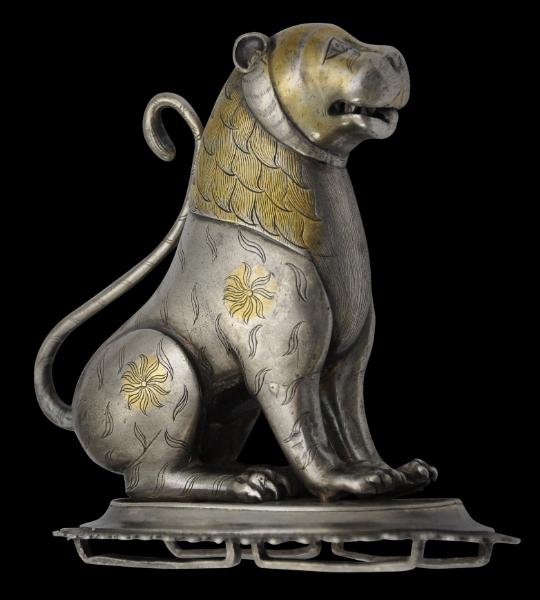
South Indian Silver-Gilt Tiger
Parcel Gilt Silver Parade Turban Ornament in the Form of a Tiger
South India, possibly Mysore
18th century
height: 10.5cm, length: 9.4cm, weight: 190g
This beautifully-made, well-modelled silver tiger is decorated with fine parcel gilding (gold plating). The tiger sits alert on his haunches and is affixed to a raised silver plate. It was designed to be attached with textile and almost certainly was made to be affixed to a turban. Two pairs of silver belt keepers or lugs can be seen on the underside of the platform on which the tiger sits. These would have been threaded with bands of cloth to allow the item to be secured in place. The top of the tiger’s head has a hole with a thread. A plume could have been secured in this to add to the overall magnificence of the decoration.
Curiously, the tiger has a lion’s mane that has been gilded, and tiger stripes over its body. The use of both lion and tiger motifs might have been an attempt to combine the fierce properties of both beasts into the one image, perhaps for protective, talismanic reasons.
The stripes are in the form of the bubri, the stylised form of the stripe adopted by Tipu Sultan, the ruler of Mysore, whose fortified palace was at Seringapatam near present-day Mysore. There are also gilded solar motifs made up of radiating bubri motifs on each of the tiger’s legs and one on the top of the head.
The tiger as an emblem often was used by India’s many local rulers. So images of tigers even in silver, are not rare. But the use of the bubri motifs is most associated with Tipu Sultan.
Tipu Sultan was also known as the ‘Tiger of Mysore’ and he adopted the tiger and the bubri as his emblems. Many of his belongings and those of his courtiers and soldiers were decorated with tiger and bubri motifs. It is possible that the silver model of a tiger dates to this time at Mysore. Certainly, the patina and styling of the piece suggest that it is eighteenth century. The bubri motifs on this item are similar to the bubri motifs on cannons captured at Seringapatam and now in the grounds of Powis Castle (see below for a photograph).
The tiger has an open moth with bared teeth and a movable tongue which just pokes from the mouth. A very long ‘S’-shaped tail is at the rear of the beast.
The plate to which the tiger is attached is oval in shape with a fine acanthus-style pierced border. The top of the plate is finely engraved with Chinese-like scrolling flower and leaf decoration.
The tiger has fine sculptural appeal. It has an excellent patina and very clear age. The contrast between the silver and the gilding is particularly beautiful. There is a (very) old minor dent to the tiger’s left cheek but otherwise the image is in excellent condition.
It is difficult to be definite that this item is associated with Seringapatam it is must remain only as a possibility. But the bubri usage is very clear, the styling is correct for the age and the patina as observed today is right for the eighteenth century. Finally, there is some variation in the tiger and motifs employed to represent Tipu Sultan, a factor alluded to by Alexander (1992, p. 184) in relation to his discussion of canons that might have been produced at Seringapatam under Tipu Sultan: ‘The great variation in quality between the various [canons] in this group is probably the result of the cannon being produced by different masters: Seringapatam must have had a very large foundry indeed.’ Similar can be said in relation to other types of goods produced in and for the soldiers, courtiers, administrators and the royal family at Seringapatam.
Tipu Sultan
Tipu Sultan – the Islamic, self-style ‘Tiger of Mysore’ – lived on a fortified island known as Seringapatam surrounded by a river, in his kingdom of Mysore. His father Hyder Ali had captured the kingdom and Tipu succeeded him as its ruler. Tipu became increasingly close to France, which alarmed the British who feared France’s expansion into the sub-continent.
The Seringapatam fortifications included a palace that housed a magnificent library of thousands of illuminated manuscripts and the toshkhana – a jewel house that held precious stones, pearls, jewellery, bullion, state documents and other important and luxury items. The entrance was guarded by chained tigers (Strong, p. 16).
Tipu Sultan’s court workshops made silver items such as howdahs for the court’s use but also to be given as diplomatic gifts. Ambassadors were sent to the Ottoman empire, to France and to the Isle de France (now Mauritius) with luxury goods produced by the workshops (Stronge, p. 18). Other luxury goods were imported from elsewhere in India, Europe, Iran and China. Tipu Sultan actively encouraged foreign trade. Embassies were sent to Istanbul and Paris to foster not just military links but also trade links.
Tipu Sultan was a great collector. Visitors who saw his collection of luxury goods prior to the fall of Seringapatam described it as ‘stupendous’ (Jasanoff, 2006, p. 184). The items came from around the world. Large quantities of gold and silver artifacts were seen in the palace when it fell in 1799 but little of it has survived. ‘Tipu Sultan’s treasury was initially plundered, and then formally distributed. Its wide dispersal has concealed from history the nature and extent of the arts of this most significant court of the eighteenth century’ (Stronge, p. 47).
The plundering that occurred essentially was illegal and for at least some time, the commanders turned a blind eye. But the process of taking ‘prizes’ was a more orderly affair governed by acts of the British Parliament whereby a prize committee was established and items were assessed and shared out according to rank.
The items taken as prizes were brought to a tent at Seringapatam from where they were distributed. No record exists of all the transactions that took place but according to Jasanoff (2006, p. 183), surviving receipts show that officers acquired ‘collectables’ such as silver betel boxes, silk carpets and ornamental weapons. Tipu Sultan’s throne was broken up and the pieces distributed.
The British were keen to remove from Seringapatam as many items as possible associated with the person of Tipu Sultan lest they become rallying points and relics of the late ruler. Jasanoff (p. 181) talks of the Sufi concept of barakat, whereby objects associated with an esteemed individual are thought to be imbued with his charisma (barakat) and contact with them will bestow blessings. But ironically, it was the British themselves who became enamoured with relics of Tipu Sultan and there developed a craze – ‘Tipumania’ – among them in India and back in Britain for collecting such memorabilia.
References
Alexander, D., The Arts of War: Arms and Armour of the 7th to 19th centuries – The Nasser. D. Khalili Collection of Islamic Art, The Nour Foundation, 1992.
Archer, M. et al, Treasures from India: The Clive Collection at Powis Castle, The National Trust, 1987.
Jasanoff, M., Edge of Empire: Conquest and Collecting in the East 1750-1850, Harper Perennial, 2006.
Stronge, S., Tipu’s Tiger, V&A Publishing, 2009.
Terlinden, C., Mughal Silver Magnificence, Antalga, 1987.
Provenance:
UK art market
Inventory no.: 3183
SOLD

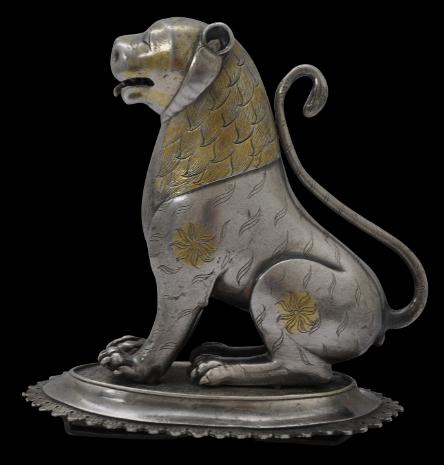

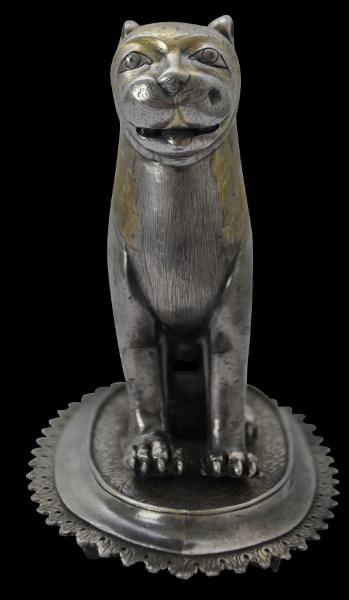
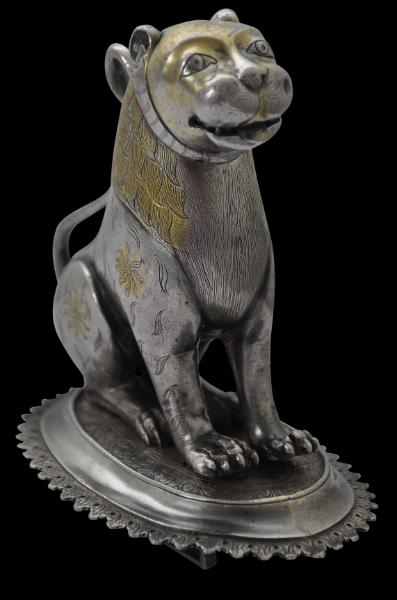

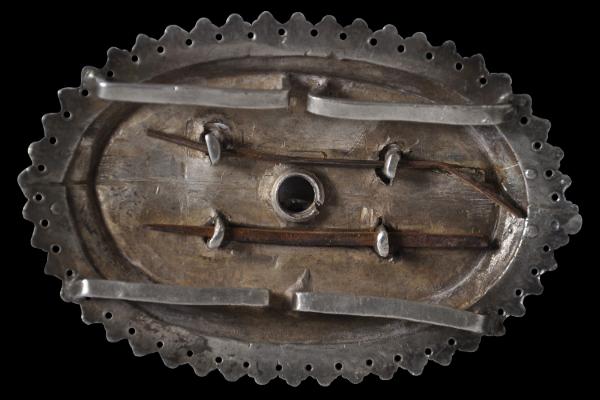
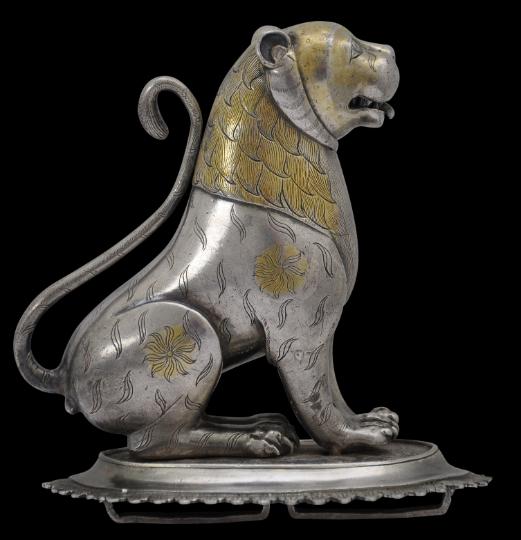
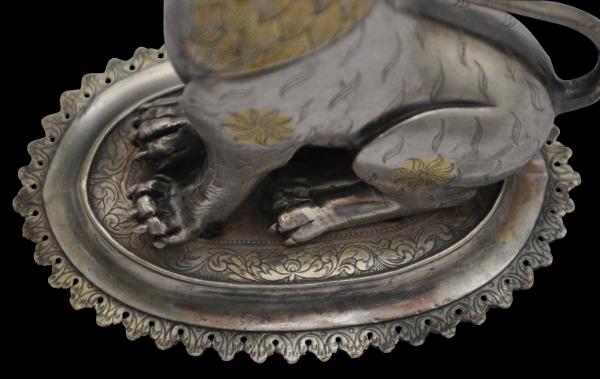
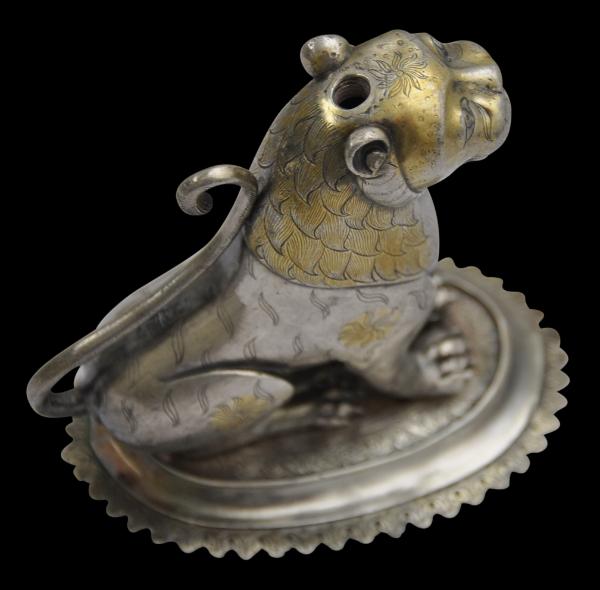
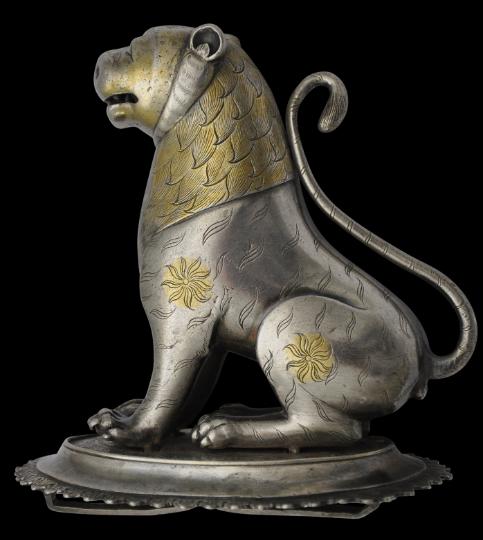


The Jamia Masjid (Mosque), built in 1787 by Tipu Sultan at Seringapatam. Photographed in January 2015. (c)
The interior of the tomb of Tipu Sultan and his father Haydar ‘Ali, Seringapatam, photographed in January 2015. Note the painted bubri motifs on the walls. (c)

The tiger-shaped muzzle of a cannon captured from Tipu Sultan’s fort as Seringapatam. Photographed at Powis Casle, Wales, in July 2014. (c)

